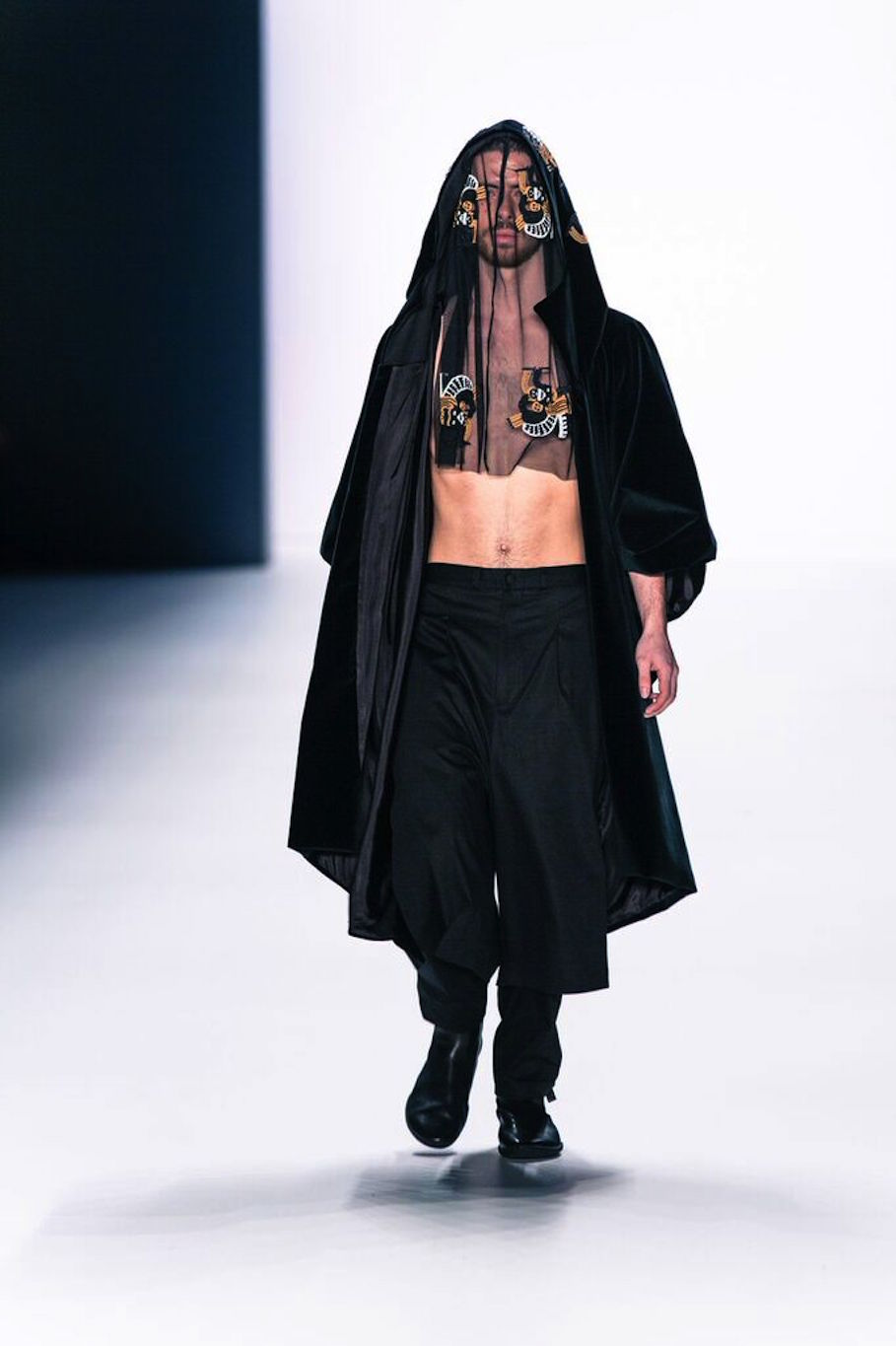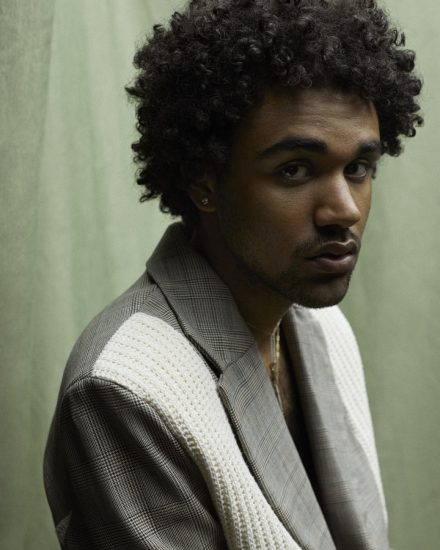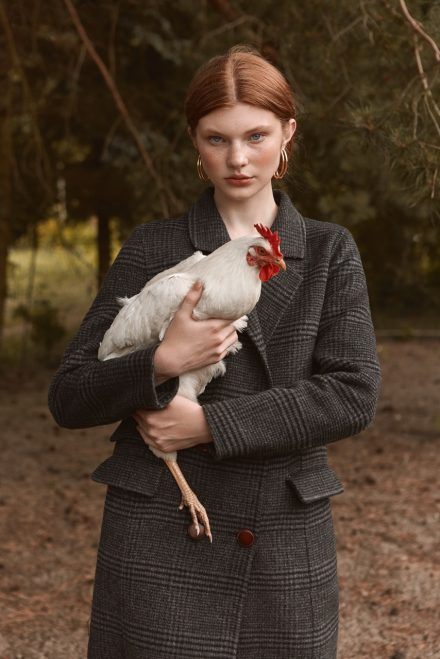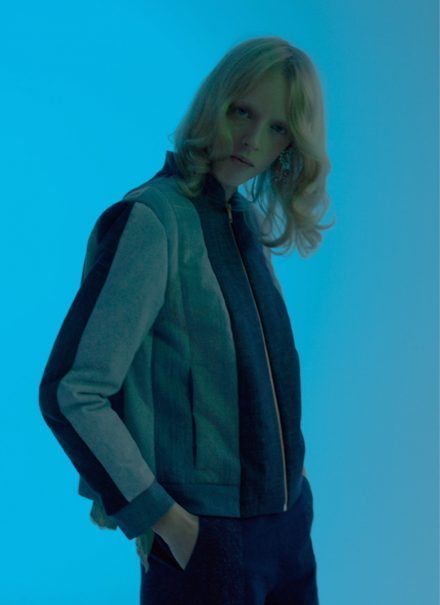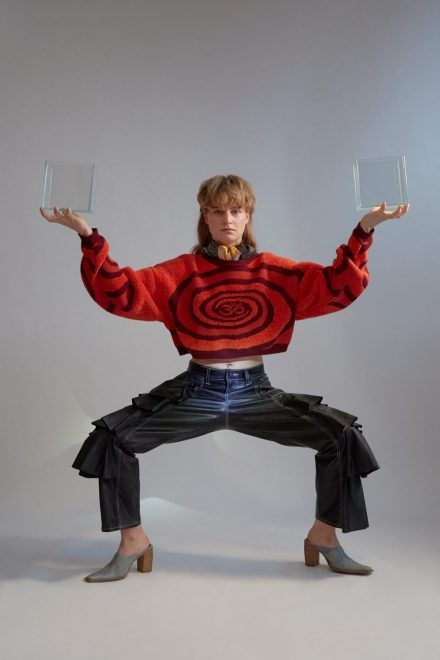 After weeks of building anticipation the games are officially open! At the Brandenburger Tor hub, streetwear prodigy Sadak kicked off the proceedings.
After weeks of building anticipation the games are officially open! At the Brandenburger Tor hub, streetwear prodigy Sadak kicked off the proceedings.
Against an ominously dubby soundtrack, the collection opened with a nod to his S/S16 offerings, infamous for the cladding of models in shimmering burqas; a cloaked figure strode the runway, face covered in a translucent, beaded veil, their lower-half clad in crisp black culottes.
Kovacecic’s mastery of tailoring certainly shows, perhaps more so than in previous collections; long, shadowy silhouettes framed by calf length coats were complemented by explicit demonstrations of the designer’s technical capacities, with certain garments offering slashed seams, while others made little effort of blending materials and textures in manners one might otherwise have considered jarring. Particularly distinctive were the employments of camouflage and tribal prints, affording a rugged grittiness to Sadak’s trademark over-sized fits.


 Images via Cora Wöllenstein
Images via Cora Wöllenstein

Over at the me Collector’s room, Ivanman opened up the stage presentations with 20 neatly tailored, brightly coloured men’s wear looks inspired by Teddy Boy fashion, a Neo-Edwardian style popularized in Britain in the 1950s. The elegance of slim fitting sweaters, button-ups and jackets alongside deftly tailored coats grounded the exuberance of this season’s kitschy color blocks and sporty fisherman pockets. The theme, of course, played well to the designer’s strength in savvy tailoring, while pushing his designs just far enough beyond the limitations of his recurrent focus on classic men’s wear.
While the colour palette may not be for the faint of heart, the collection itself is comprised of easy-to-wear, buildable wardrobe staples containing just enough design gumption to sidestep the commonplace. Subtle details found in belt loops, pockets, and coat collars help bring modern finishings to reinterpret time-honored, functional pieces.



Images via Mercedes-Benz Fashion Week Berlin
 Nobi Talai’s A/W offerings were presented in an altogether more sumptuous context. In a cosy suite partitioned into three rooms at the Kronprinzenpalais, a collection resplendent in warmth, refinement and elegance was revealed.
Nobi Talai’s A/W offerings were presented in an altogether more sumptuous context. In a cosy suite partitioned into three rooms at the Kronprinzenpalais, a collection resplendent in warmth, refinement and elegance was revealed.
Fluid, draping silhouettes in a palette of blacks, greys, beiges and flashes of deep ochre evoked mystery, luxury, and adventure, paying homage to the nomadic traditions of her native Iran. The designer proved an intimate acquaintance with the art of textural layering, unveiling seldom seen depth with fine knits draped over buttery leathers, and flowing felted capes draped over clean, fitted turtlenecks.
While the importance of tradition was evident, the richness and relative pomp was artfully cut through by pieces that anchored the collection in the here and now, head dresses reminiscent of Nigerian Gele head ties and boxy black razor-cut jackets.


 Images via Stefan Kraul
Images via Stefan Kraul
 When asked what the overarching message for this season’s collection should be, it takes Dawid Tomaszewski little time to quip, “Be Beautiful!” And beautiful the collection certainly was, featuring an astonishing breadth of tones, textures and silhouettes, casting the garments and their component materials as objects of finest luxury.
When asked what the overarching message for this season’s collection should be, it takes Dawid Tomaszewski little time to quip, “Be Beautiful!” And beautiful the collection certainly was, featuring an astonishing breadth of tones, textures and silhouettes, casting the garments and their component materials as objects of finest luxury.
Speaking of one of the signature looks of the collection, a trained evening dress in deep scarlet worn over a soft grey turtleneck, he claims, “you don’t need jewellery, you need knitwear”. Rather than accentuating the looks with accessories, decorative elements were integrated into the garments themselves, be that through the use of varying densities of threads, ornate beadwork or the reinventing of conventional silhouettes in unorthodox materials and textures. This season offered a fresh facet of Tomaszewski’s work, but rest assured, the ethics that have garnered him wide acclaim remain intact:
“In my opinion, a product should be beautiful. When we produce the products, we love them, as if they were pieces of art. […] I love art, but I work as fashion designer. They are different pools, but [through my work] I try to bring them together.”



Images via Andreas Rentz

Among the regular designers on the Berlin Fashion Week schedule, few are as acclaimed in their ability to create a spectacle than Esther Perbandt. Taking over the vast hall of Radialsystem V, attendees awaiting theatricality were not let down.
Opening the show, four identically black clad figures flanked the stage, each lifting a square of black fabric, the centre of which was composed of loosely woven strips. In a rivetingly abstract set of movements, the performers interacted with the squares, wearing them as dresses, coats, even ponchos. Thus, the show’s precedent was set, with the interrogation and reinterpretation of traditional forms placed front and centre.
The collection adhered to Perbandt’s quintessentially shadowy colour scheme, albeit often offering complementary looks in dazzling whites, often near-reflections of the sombre look gone before. Waistcoats, chunky knit sweaters and sweeping trench coats were denuded of their common associations, often deconstructed, distressed, or obscured by panels of stiff fabrics, thereby exposing new potential in vestiary contexts one may have originally thought firmly rooted in tradition. Most striking of all was the closing look, a dress of celestial white reminiscent of a bridal gown, the back of which had been exposed.



Images via Mercedes-Benz Fashion Week Berlin
